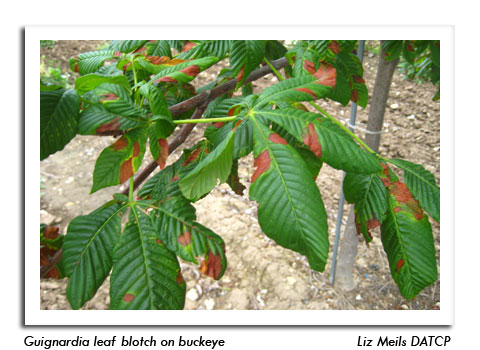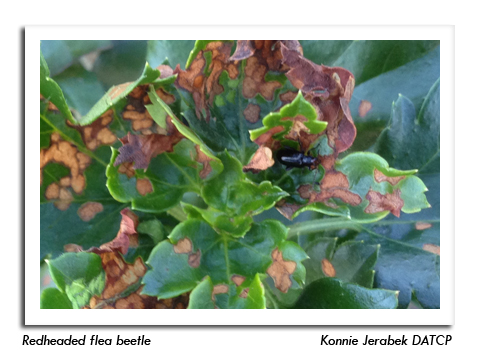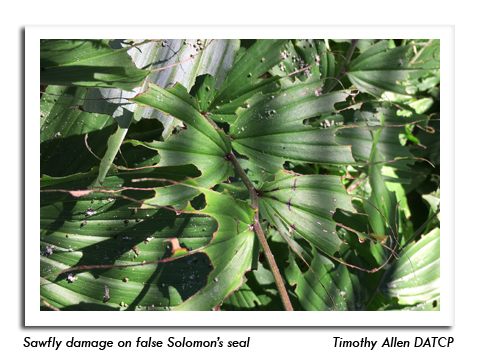
 |
|
|
Nursery & Forest
Volume 63 Number 12 Date 07/19/2018 GUIGNARDIA LEAF SPOT - Leaf spots on buckeye trees indicative of this fungal disease were observed at a nursery in Rock County, and are common in Wisconsin this season. The large, blotchy leaf spots with yellow margins may cause early defoliation when infection is severe, particularly during wet summers. Removal and destruction of fallen leaves may help reduce infection in future years. Because this disease is primarily aesthetic and does not threaten the long-term survival of the tree, chemical control is not advised. CEDAR-APPLE RUST - Severe infection of cedar-apple rust was found on the apple variety "Wealthy" at a nursery in southwestern Wisconsin. This fungal disease requires two hosts to complete its life cycle: Juniperus sp. and Malus sp. Symptoms on apple trees are most evident on leaves, but can also occur on the fruit and stems. The leaves show bright rust-colored circular spots on the upper surface in spring. Later in the summer, fungal telial columns protrude from the lesions, releasing spores to be blown to eastern red cedar. Rust galls form on the eastern red cedar the following year (the fungus completes its lifecycle in two years). Management options include separation of the two hosts by one mile, planting resistant cultivars, and fungicide application prior to infection. -- Shanon Hankin, DATCP Nursery Inspector REDHEADED FLEA BEETLE - These shiny black beetles with prominent reddish heads are reportedly abundant in field crops in Clark and Taylor counties. Nurseries are also likely to be impacted given the high numbers observed. Defoliation caused by flea beetle feeding varies by leaf type, appearing as skeletonizing or shredding on thinner leaves and a linear, leafminer-like pattern on the thicker, fleshy leaves of sedum and similar plants. Insecticides directed against the adults are the most effective control, with more than one application usually required. SAWFLY - Several beds of false Solomon's Seal that had been decimated by sawfly larvae (Phymatocera sp.) were noted last week in Marathon County. The larvae feed on the undersides of leaves, stripping tissues between the leaf veins. If not detected early, sawfly larvae can rapidly defoliate plants. -- Timothy Allen, DATCP Nursery Inspector EMERALD ASH BORER - On June 28, emerald ash borer (EAB) was detected for the first time in St. Croix County, reported from both the City and Town of Hudson. St. Croix is the first new county detection of 2018 for Wisconsin and the 49th since EAB was first discovered in 2008. Municipal detections total 433 statewide (green on the map), with the majority in the southern half of the state. As of March 30, a statewide EAB quarantine emergency rule is in effect, permitting free movement of ash and other regulated articles such as firewood between counties. Prior to the statewide quarantine, county-level quarantines helped reduce the spread of EAB in the past decade. Restrictions on firewood on state and federal lands remain in effect, and it is important to "buy it where you burn it" or purchase firewood that has been certified pest free by DATCP. EAB adult emergence has peaked across the state (1,000 GDD base 50°F) and the beetles can be found flying about the upper canopy, feeding on ash leaves or laying eggs on tree bark. Although the ideal treatment window for systemic and topical pesticide applications has passed, Imidacloprid soil applications can be made in the fall (September-October) if an infested tree was recently identified. Otherwise, soil drench, injection or basal trunk spray treatments should be planned for next spring (April-June), when they are most effective. -- Renee Pinski, DATCP Forest Entomologist 




|
|
|